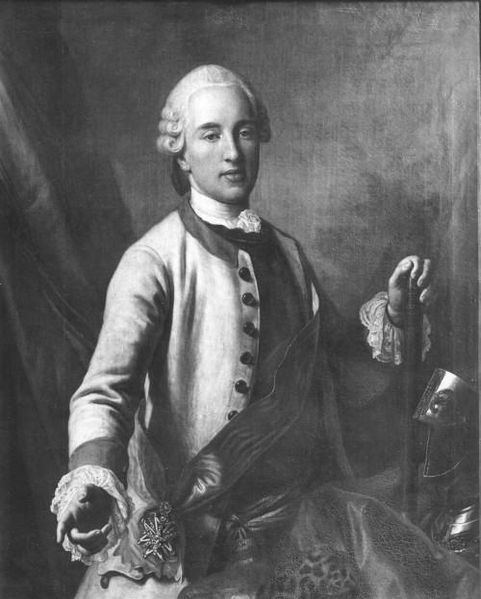Burial Katholische Hofkirche | Name Prince Xavier | |
 | ||
Reign 17 December 1763 – 23 December 1768 Born 25 August 1730Dresden ( 1730-08-25 ) Issue Ludwig, Graf von der LausitzClara Maria, Grafin von der LausitzJoseph Xavier, Graf von der LausitzElisabeth Ursula, Duchesse d'EsclignacMaria Anna, Princess of OrioloBeatrix Marie, Marchesa di CorletoKunigunde Anna, Marchesa Naro MontoroMaria Christina Sabina, Princess of Arsolistillborn sonCecilie Marie, Grafin von der Lausitz | ||
Franz Xavier of Saxony (b. Dresden, 25 August 1730 – d. Dresden, 21 June 1806) was a German prince and member of the House of Wettin.
Contents

He was the fourth but second surviving son of Augustus III, King of Poland and Elector of Saxony, and Maria Josepha of Austria.
Regent of Saxony
His older brother, the Elector Frederick Christian, died on 17 December 1763 after a reign of only 74 days. Franz Xavier took over the regency of the Electorate together with his sister-in-law, the Dowager Electress Maria Antonia of Bavaria, on behalf of his infant nephew, the new Elector Frederick Augustus III. As co-regent, Franz Xavier continued the rationalistic reforms of his brother.
In October 1765, Franz Xavier performed in the name of the young Elector a formal renunciation of the Polish Crown in favor of Stanislaus Poniatowski, as was required by the treaty signed between Prussia and Russia on 11 April 1764. This was done against the wishes of the boy's mother, the Dowager Electress Maria Antonia. During the regency, Franz Xavier attempted to introduce a plan of army reform based upon the Prussian model of Frederick the Great. This brought him into conflict with the estates of the country, who violently refused to implement his proposal because of the high expense associated with his reorganization plan.
According to the regulations imposed by the Golden Bull of 1356, the regency of an underage Elector ended when he reached his eighteenth birthday. As a result, in 1768, the Elector Frederick Augustus III was formally proclaimed an adult, and Franz Xavier ended his functions as the regent of the Electorate of Saxony.
Secret Marriage, Exile and Return to Saxony
In Dresden on 9 March 1765 Franz Xavier married morganatically an Italian lady-in-waiting to his sister-in-law, the Dowager Electress, the contessa Maria Chiara Spinucci. The union was keep secret until 1777 when it was formally announced and legitimized.
In 1769, Franz Xavier moved his family to France, the home of his younger sister, the Dauphine Marie-Josèphe, who had died two years earlier. He lived in France for almost twenty years under the assumed title of Count of Lusatia (fr: Comte de Lusace, de: Graf von der Lausitz). In 1774, his nephew, Louis XVI, became the king of the country. Franz Xavier and his family chose to flee France at the beginning of the French Revolution. They moved to Rome; while in Rome, the Prince sat for a bust by Domenico Cardelli. After the death of his wife in 1792, he remained in Rome for some years. Eventually, though, he returned to Saxony and settled into Schloss Zabeltitz. Franz Xavier lived there until his death, aged seventy-five.
Issue
During their marriage, Franz Xavier and Maria Chiara had ten children —known as counts and countesses of Lusatia (de: Graf/Gräfin von der Lausitz) — but only six survived to adulthood:
- Ludwig Ruprecht Joseph Xavier (b. Dresden, 27 March 1766 - d. Pont-sur-Seine, 22 August 1782).
- Clara Maria Augusta Beatrice (b. Dresden, 27 March 1766 - d. Dresden, 18 November 1766), twin with Ludwig.
- Joseph Xavier Karl Raphael Philipp Benno (b. Dresden, 23 August 1767 - killed in a duel at Teplitz by Russian prince Nicholas Shcherbatov, 26 June 1802), called "Le Chevalier de Saxe".
- Elisabeth Ursula Anna Cordula Xaveria (b. Dresden, 22 October 1768 - d. Dresden, 3 May 1844), called "Mademoiselle de Saxe"; married on 8 November 1787 to Henri de Preissac, Duc d'Esclignac.
- Maria Anna Violente Katharina Martha Xaveria (b. Siena, 20 October 1770 - d. Rome, 24 December 1845), married on 15 October 1793 to Principe Don Paluzzo Altieri, Principe di Oriolo.
- Beatrix Marie Françoise Brigitte (b. Chaumot, 1 February 1772 - d. Dresden, 6 February 1806), married on 18 February 1794 to Don Raffaele Riario-Sforza, Marchese di Corleto.
- Kunigunde Anna Helena Maria Josepha (b. Chaumot, 18 March 1774 - d. Rome, 18 October 1828), married on 1795 to Marchese Don Giovanni Patrizi Naro Montoro.
- Maria Christina Sabina (b. Pont-sur-Seine, 30 December 1775 - d. Rome, 20 August 1837), married on 24 March 1796 to Don Camillo Massimiliano Massimo, Principe di Arsoli.
- Stillborn son (Pont-sur-Seine, 22 December 1777).
- Cecilie Marie Adelaide Augustine (b. Pont-sur-Seine, 17 December 1779 - d. Pont-sur-Seine, 24 June 1781).
